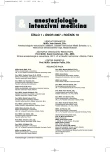Incidence of postoperative residual curarization following cisatracurium and rocuronium-induced neuromuscular block: a prospective study
Authors:
M. Adamus; J. Koutná; D. Žáčková
Authors‘ workplace:
Klinika anesteziologie a resuscitace, Fakultní nemocnice a Lékařská fakulta Univerzity Palackého, Olomouc
Published in:
Anest. intenziv. Med., 18, 2007, č. 1, s. 30-34
Category:
Anaesthesiology - Original Paper
Overview
Objective:
To assess the incidence of postoperative residual curarization following cisatracurium and rocuronium-induced neuromuscular block.
Design:
Clinical, prospective, controlled study.
Setting:
Department of Anaesthesiology and Intensive Care Medicine, University Hospital,
Materials and methods:
We investigated residual curarization after general anaesthesia with either cisatracurium (CIS, n = 384) or rocuronium (ROC, n = 406) induced neuromuscular blockade without peroperative neuromuscular blockade monitoring in 790 patients. On admission to the recovery room we performed submaximal stimulation of the ulnar nerve (30 mA) and quantified the evoked muscle response with accelerometry (TOF-Watch® SX SX, Organon). The postoperative residual curarization was defined as TOF-ratio < 0.90, p < 0.05 was considered significant.
Results:
Postoperative residual curarization could be demonstrated in 24.5 % (CIS group) and 32.0 % (ROC group), respectively. Compared to the group with adequate neuromuscular recovery, the patients with residual blockade received a larger relaxant dose, were anaesthetised by a less experienced anaesthetist, a shorter time had elapsed since the last relaxant dose, their core temperature was lower and on average, they received less neostigmine at the end of anaesthesia (p < 0.05).
Conclusion:
The incidence of postoperative residual curarization remains a problem even following intermediate - acting neuromuscular blockers (cisatracurium, rocuronium). We suggest reversing the residual block after cisatracurium or rocuronium routinely, especially in the absence of perioperative neuromuscular monitoring.
Keywords:
postoperative residual curarization – cisatracurium – rocuronium – TOF-ratio – postanaesthesia care unit
Labels
Anaesthesiology, Resuscitation and Inten Intensive Care MedicineArticle was published in
Anaesthesiology and Intensive Care Medicine

2007 Issue 1
Most read in this issue
- The American Society of Anesthesiologists’ (ASA) Classification of Physical Status – time for change?
- Lev Spinadel – founder of anaesthesiology in Czechoslovakia
- Incidence of postoperative residual curarization following cisatracurium and rocuronium-induced neuromuscular block: a prospective study
- Early urine and blood biochemical changes in experimental model of sepsis
